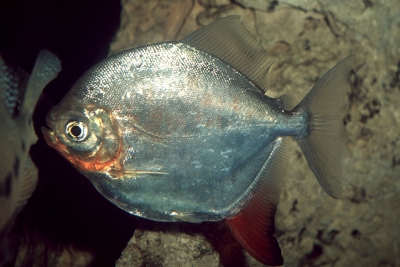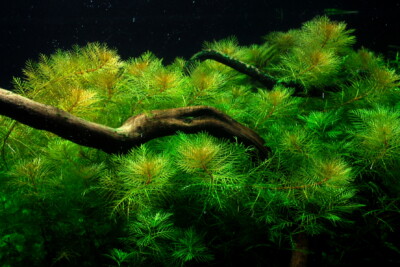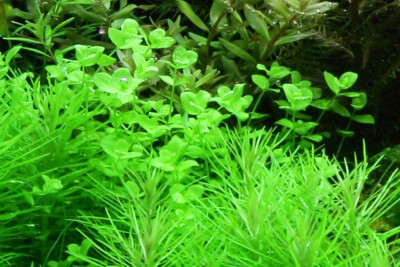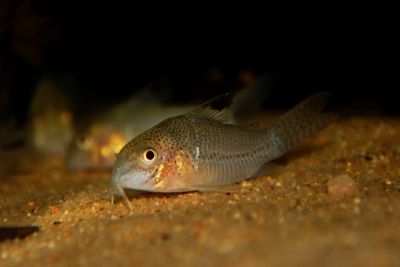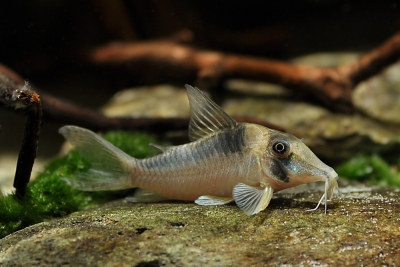shirui
- Corydoras panda
Corydoras panda
- Corydoras panda
| Family | Callichthyidae |
|---|---|
| Genus | Hoplisoma |
| IUCN category (World) | NT |
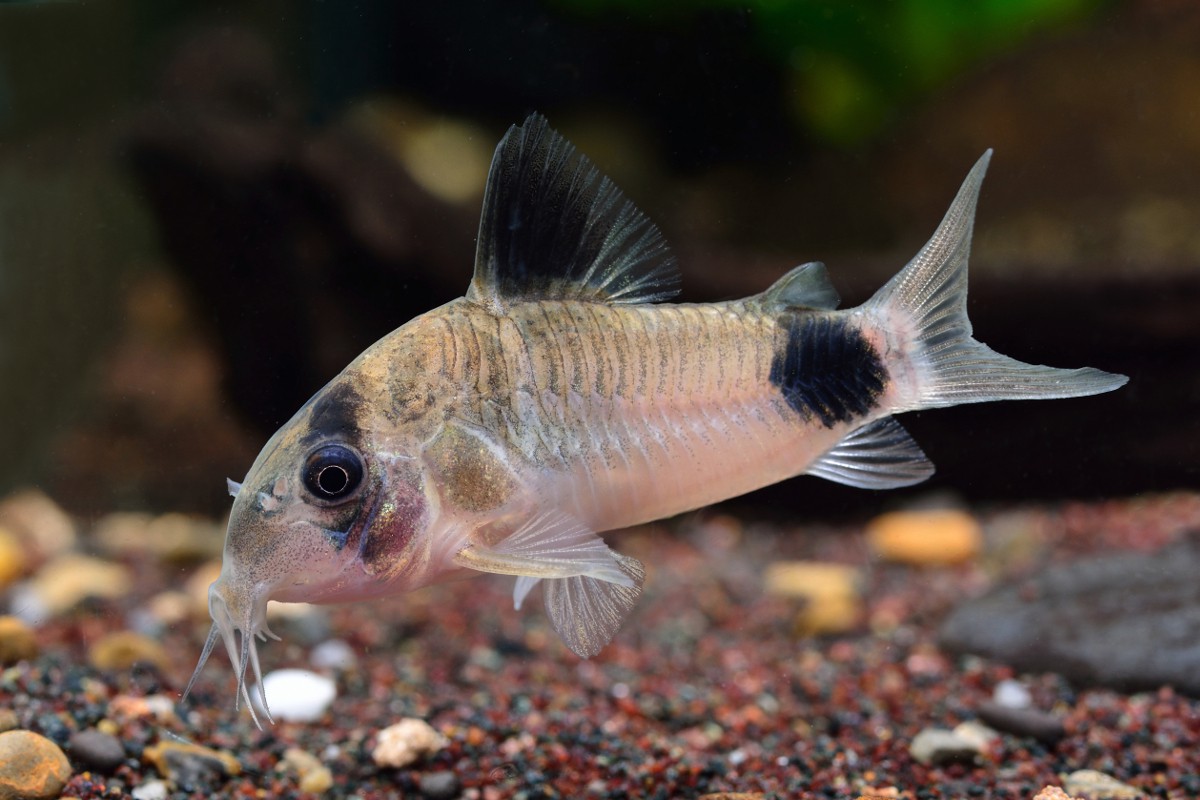

Introduction
Corydoras panda is a tropical freshwater fish native to the Amazon basin in the Peruvian part.
Who is it?
Morphology
-
Average size4 cm
-
Maximum size6 cm
-
Longevity5 year
-
Average size4 cm
-
Maximum size6 cm
-
Longevity5 year
How to recognize This fish ?
Corydoras Panda has a black band over the eyes, a black band on the caudal peduncle, and a fairly black dorsal fin. The rest of the body varies from white to brown to beige.
Sexual dimorphism
No blatant physical difference between sexes. However, males have pointed dorsal and pelvic fins while they are rounded in females. This difference is more easily observable when looking at the fish from above.
Furthermore, it is possible, through careful observation, to differentiate adult subjects as females are wider and taller than males and have a more rounded abdomen.
Behaviour & Life cycle
-
dietomnivorous
-
Sociabilityliving in shoals
-
territorialNo
-
Way of livingdiurnal
Corydoras panda is a schooling fish that generally resides at the bottom, often resting on the sand. They are rather lively and very active fish. In general, they are very independent and do not pay much attention to other species. Females seem to lead the group but these elements would deserve to be completed.
Like all Corydoras, the panda sometimes swim to the surface to ingest a bubble of air. This is a type of "intestinal" summer respiration that is sometimes used by many species, including in France, such as barbels or carps. These fish all have the particularity of living at the bottom. This characteristic would seem to indicate a natural ability to provide an oxygen supplement to their organism when the need arises.
Reproduction
-
Reproductionovipare qui pond sur substrat découvert
Corydoras panda is an oviparous fish that spawns on exposed substrate (leaves, roots...) after seasonal rains.
Harmless species
This species does not represent any particular threats to humans when encountered in its natural environment.
Origin and distribution
Geographic distribution & Conservation
Corydoras Panda is a species living in Peru in the Rio Ucayali and other connected Rio (Rio Zungaro, Rio Sungaro, Rio Aguaytia, Río Pachitea, Rio Aguaytia). It lives in both clear and crystalline river waters and in blackwater streams.
Conservation status of populations (IUCN)
What is its habitat?
Natural environment characteristics
-
Temperature20 - 25 °C
-
pH (acidity)6 - 7.5
-
gh (hardness)2 - 12
Biotope presentation
Corydoras panda naturally resides in slightly acidic water. The ground is generally made up of sand.
Species of the same biotope
Main recommendations for fishkeeping
Deontology
In order to preserve wildlife, if you acquire this animal, it must not be released into the wild. See also, the Fishipedia charter.
Fishipedia supports the practice of responsible and environmentally friendly aquarium keeping. We encourage maintenance if it is motivated by a desire to understand the biological functioning of living things and if it is done with respect for animal life.
We believe that aquaristics is an opening to the discovery of aquatic environments, especially freshwater, and that this knowledge is necessary to better protect and respect these environments. Logically, we refute the compulsive purchase of animals that would not find a sufficient and / or adapted place in the host aquarium.
Our recommendations
-
Min volume80 liters
-
Population min8
-
Temperature20 - 25 °C
-
pH (acidity)6.8 - 7.2
Characteristics
-
Difficulty breedingeasy
-
Robustnesstolerant
-
Behaviourpeaceful
-
Availabilitystandard
Recommended equipment from our partners
-
Aquarium
-
Filtration
General reminders
It is strongly advised to read the complete dedicated file and to get information on the feedbacks of maintenance of the envisaged animal, this to avoid any potential conflict whose end result is generally the death of the individual (or the other inhabitants). It is important not to overload your aquarium to limit pollution. This will make maintenance easier.
In nature, animals are subject to weather conditions and live in waters with variable characteristics. The recommendations offered by our team for aquarium maintenance are a guidance and cannot be assimilated to scientific datas.
General reminder on maintenance datas
Le démarrage d'un aquarium est une partie primordiale pour l'équilibre et le bien-être des poissons. Lorsque l'on met en eau un aquarium, l'eau passe naturellement par un cycle biologique : le cycle de l'azote. Celui-ci dure environ trois semaines. Tous les 2 jours, nous vous conseillons de tester votre eau jusqu'à ce que le taux de nitrite soit à zéro pendant plusieurs jours d'affilée.
Pour accélérer ce cycle, vous pouvez utiliser un activateur de bactéries comme JBL Denitrol. Cette solution riche en bactéries vivantes et enzymes permet une mise en place rapide du cycle de l'azote. Les poissons peuvent alors être introduits plus rapidement.
Il est important de tester l'eau de son aquarium régulièrement pour maintenir un environnement sain pour les poissons et les autres habitants. Les tests d'eau permettent de mesurer les niveaux de différents paramètres tels que le pH, la dureté totale, ainsi que les taux de nitrates, de nitrites et d'ammoniaque.
Pour réaliser ces tests, vous pouvez utiliser des produits d'analyse spécialisés tels que JBL ProScan qui permet de réaliser un diagnostic de l'eau directement via un smartphone. Il existe également des coffrets de tests plus classiques de bandelettes, comme JBL PROAQUATEST.
En cas d’usage de l’eau du robinet, vous pouvez utiliser un conditionneur d’eau de type Biotopol de JBL pour éliminer les substances nocives comme le chlore, le cuivre, le plomb et le zinc. Une eau trop dure ou trop calcaire peut être inadaptée à de nombreuses espèces tropicales d’eau douce. Si nécessaire, vous pouvez la couper avec de l’eau osmosée ou de pluie filtrée afin d’obtenir une dureté plus adaptée aux besoins de vos poissons et de vos plantes. Les conditionneurs d'eau garantissent une meilleure santé aux poissons et une meilleure croissance des plantes.
Chlorine and chloramine are dangerous for the health of animals. Used to disinfect water, these agents are present in significant quantities in tap water. We recommend using an anti-chlorine agent every time you change the water. In addition to chlorine, treatments and medicines sold for aquarium use sometimes contain dangerous heavy metals in high doses.
Specific needs for the shirui
The shirui is a species which lives naturally at a temperature between 20 °C and 25 °C. Nitrate levels should remain below 50mg/L. To keep the water clean and unpolluted, plan on changing 20% to 30% of the water volume each month.
Breeding this species is accessible to any hobbyist. It is recommended to follow some basic rules and to be rigorous to achieve a good maintenance.
This species is particularly common in the aquarium trade. Animals from long-term breeding are usually acclimatized at a temperature of about 26 °C in neutral water.
Cohabitation & Environment
Being a living in shoals fish, it is advisable to install at least 8 individuals in an aquarium of 80 liters minimum (for 50 cm of frontage). Group maintenance is a prerequisite to ensure their well-being. Lonely individuals tend to quickly become stressed and become especially susceptible to disease. Although sometimes certain groups can "merge", mixing several gregarious species living in the same zone of life is not recommended if the volume is not consequent.
The shirui is a peaceful species that generally does not exhibit behavioral problems in a community aquarium.
Tips for feeding
The shirui is omnivorous.
This species can eat dry food (flakes, pellets), fresh food and frozen food. To avoid deficiencies, it is recommended to vary the types of food.
Feed animals in moderation to maintain good water quality. Meals should be eaten within 2–3 minutes, served in several small portions rather than a single large ration.
Uneaten food quickly decomposes, releasing ammonia, nitrites, and nitrates, which disturb the aquarium’s biological balance.
Make sure each species can access food properly, slower or bottom-dwelling individuals may require targeted feeding.Food recommendations from our partner JBL - Products PRONOVO
-
Granules
-
Flakes
-
Sticks
Reproduction protocol
-
Maintenance difficultymoderate
-
egg-laying protectionYes
Hybridization risks
In general, it is advised not to mix several species of the same genus or different varieties of the same species, to avoid the risks of hybridization.
These animals might interest you
These plants might interest you
Plants play a crucial role in aquariums, both for their ability to filter water by absorbing excess nutrients and for their aesthetic contribution. They provide fish with natural hiding places, can serve as breeding sites, and generally help maintain the overall balance and optimal conditions of the aquarium. The selection presented here includes species from the same regions as the species described on this page, although they do not necessarily come from its exact natural biotope.
To go further
Sources & Contributions
Participation & Validation
The Fishipedia team and specialist contributors are committed to providing high-quality content. However, although the information comes from scientific sources or testimonials from specialists, the cards may contain inaccuracies.

Benoit Chartrer
Translation
Translation done with the valuable contribution of our translators, who make this information available to a wider audience. We sincerely thank them for their commitment.
Scientific partners
Species of the same family
Same genus
Species of the same biotope










